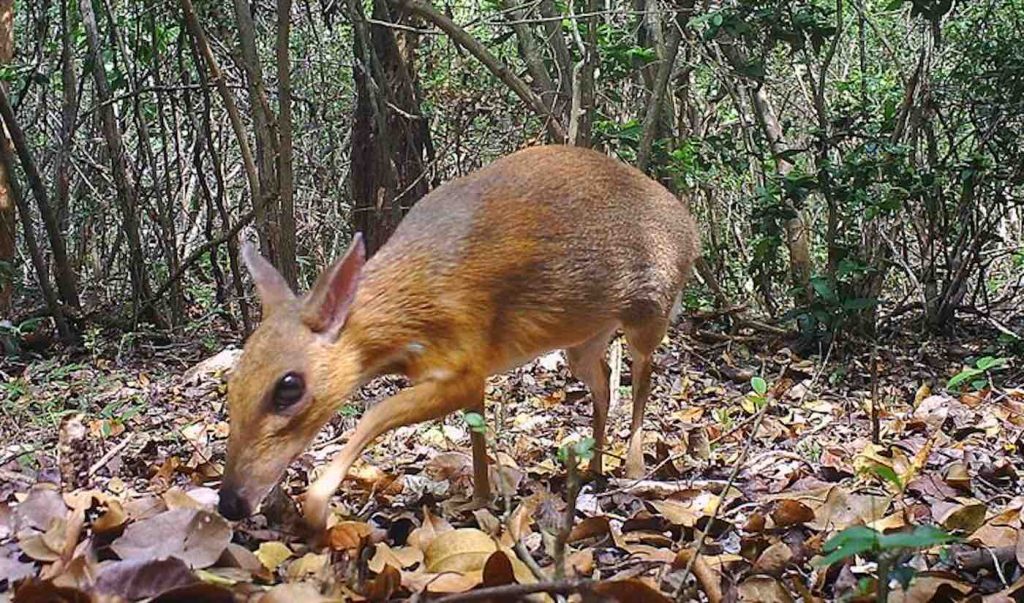In a time when species are disappearing faster than ever, the recovery of a tiny, rabbit-sized animal in Vietnam offers a rare glimmer of hope. After being “lost” for nearly three decades, the silver-backed chevrotain, also called the Vietnamese mouse deer, has been rediscovered in the wild—alive, alert, and photographed for the first time since 1990.
This breakthrough isn’t just a win for conservation. It’s a symbol of how recovery is possible, even after decades of silence. And in a world where efforts to preserve nature compete with tech, law, and finance, this story reminds us how important it is to support scientific missions—whether through donations, policy, or public awareness.
What Is the Vietnamese Mouse Deer?
The silver-backed chevrotain is an elusive and mysterious animal. It’s not actually a mouse, and not quite a deer, but rather a tiny hoofed mammal (ungulate) that weighs less than 11 pounds (5 kg). Despite its name, it belongs to a family of ancient creatures found in parts of Asia and Africa, and is known for its silver-gray flanks, tiny fangs, and delicate gait that makes it look like it’s walking on tiptoes.
The species was first described in 1910, and after a final sighting in 1990, it vanished—slipping off the radar of biologists, researchers, and governments. For nearly 30 years, many believed it had gone extinct.

A Rediscovery That Sparked Global Excitement
That changed when Global Wildlife Conservation (GWC), together with the Southern Institute of Ecology and Leibniz Institute for Zoo and Wildlife Research, launched an expedition in southern Vietnam.
Their approach? Not high-end tracking software or satellite imaging, but listening to locals—rural villagers and forest rangers—who reported seeing a strange silver-colored animal.
“We had no idea what to expect,” said An Nguyen, expedition leader and associate scientist with GWC. “I was shocked and overjoyed when we checked the camera traps and saw photos of a mouse deer with silver flanks.”
They placed three motion-triggered camera traps in suspected habitats for five months, capturing 275 images of the elusive creature. Encouraged, the team expanded to 29 more cameras, and in another five months, they recorded 1,881 photographs of the mouse deer.
📸 Full Story: The hidden meaning behind Princess Diana’s Cannes gown – A heartfelt farewell
Why This Matters for Conservation—and Recovery
This discovery was a major win for the GWC’s “Search for Lost Species” project. The silver-backed chevrotain ranked high on their top 25 most-wanted lost species list, and its rediscovery marks the first mammal on that list to return.
And this is more than a feel-good story. It changes the way scientists look at biodiversity in Southeast Asia.
“The rediscovery of the silver-backed chevrotain provides big hope for the conservation of biodiversity, especially threatened species, in Vietnam,” said Dr. Hoang Minh Duc, head of zoology at the Southern Institute of Ecology.
With over 10 known chevrotain species worldwide, this silver-backed one is uniquely Vietnamese, making it a national treasure. Its comeback gives hope that other “lost” species may still be out there, waiting to be found—and protected.
What’s Next for the Mouse Deer?
Rediscovery is just the beginning. Scientists now face urgent questions:
-
How many chevrotains are left?
-
Where do they live exactly?
-
What threats do they face—hunting, habitat loss, or climate?
In response, conservation teams are launching the first comprehensive population survey for this species. They’re placing cameras in two more protected zones, tracking sightings, analyzing habitats, and even preparing an action plan to ensure these animals don’t go “lost” again.
They’re also strengthening law enforcement in these areas—ensuring illegal hunting and forest clearing don’t undo the progress already made.
🧠 Related Read: This man lost 360 pounds naturally—and the internet rallied to support him

A Wake-Up Call for the World
The survival of the mouse deer is a reminder that species disappear quietly—not always with a dramatic extinction announcement. It takes donors, scientists, and even attorneys advocating for conservation laws to protect these species.
We live in a world flooded with innovation—medical software, digital finance, AI lawyers—but our connection to nature is just as critical. We must donate to causes that protect our biodiversity. Without it, we risk losing the very essence of the world we live in.
And this isn’t just about Vietnam. The mouse deer’s home in the Greater Annamite Mountains is one of the world’s most biologically rich but under-protected regions. Other rare species here include the saola, sometimes called the “Asian unicorn,” which was only discovered in 1992 and still hasn’t been seen in the wild.
Final Thoughts: Don’t Let It Disappear Again
From myth to memory, the silver-backed chevrotain has made its way back into science books—and into the hearts of conservationists everywhere. But without continued support, the risk of losing it again is real.
This animal’s story reminds us that even when something seems lost forever, recovery is possible. It just takes patience, belief, and the right people backing the mission.
So whether you’re a scientist, a student, an activist—or just someone reading this with curiosity—know that you, too, can be part of the recovery. Donate, share, speak out, and support the people working to save life on Earth before it vanishes.



